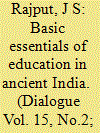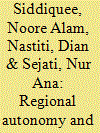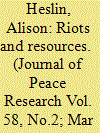|
|
|
Sort Order |
|
|
|
Items / Page
|
|
|
|
|
|
|
| Srl | Item |
| 1 |
ID:
126649


|
|
|
| 2 |
ID:
083598


|
|
|
|
|
| Publication |
2008.
|
| Summary/Abstract |
This article covers the period from the Islamic Revolution to Khatami's landslide victory at the presidential elections in 1997 and analyses the processes leading to the formation of a national movement in Iranian Azerbaijan. It successively explores the role played by the Turkish intellectual entrepreneurs, former Leftists and disillusioned Islamists in politicizing Azerbaijani identity and shaping a nationalist movement. This process of aggregation of different social groups reveal what has now become one of the main symptoms of the profound crisis faced by the Islamic Republic
|
|
|
|
|
|
|
|
|
|
|
|
|
|
|
|
| 3 |
ID:
116959


|
|
|
|
|
| Publication |
2012.
|
| Summary/Abstract |
What explains the galvanising of communities to participate actively in energy projects? How do groups mobilize to overcome the often formidable barriers highlighted in the existing literature? Drawing on original qualitative research of 100 community energy groups in Scotland, including six in-depth case studies, we explain how effective mobilization occurs and the political dynamics surrounding such mobilization. To capture these dynamics, we adapt theories offered by literature on social movements, with a particular focus on resource mobilization theories. Applying our adapted framework, we identify two particular sets of resources shaping community energy mobilization: (i) structural resources, which refer to the broad political context structuring and constraining opportunities for community energy mobilization; and (ii) symbolic resources-less tangible resources used to galvanise participants. We investigate to what extent our case study groups were able to draw upon and exploit these resources. We find that structural resources can either facilitate or hinder mobilization; what matters is how state resources are exploited and constraints mitigated. The use of symbolic resources was highly effective in aiding mobilization. Each of the groups examined - despite their considerable variation - effectively exploited symbolic resources such as shared identity or desire for strong, self reliant communities.
|
|
|
|
|
|
|
|
|
|
|
|
|
|
|
|
| 4 |
ID:
113045


|
|
|
|
|
| Publication |
2012.
|
| Summary/Abstract |
Does fiscal decentralization empower sub-national governments to raise sufficient revenue from local sources thereby reducing their dependence on the national government? This paper addresses this question by focusing on Indonesia's most recent decentralization policy and assessing and analysing the role of local governments in this regard. Based on data collected from two different locations in Eastern Indonesia the paper shows that the dependency of local authorities on central government is excessive and that the share of local revenue in regional budget has remained rather small. It also shows that while the fiscal power granted to local governments is limited, a combination of politico-economic and contextual factors has further undermined the prospect of revenue mobilisation at the local level.
|
|
|
|
|
|
|
|
|
|
|
|
|
|
|
|
| 5 |
ID:
193232


|
|
|
|
|
| Summary/Abstract |
Security partnerships between unequal partners walk a fine line between mutually beneficial cooperation and coercion. This article theorizes resource provision in security partnerships in which a funder substantively supports a recipient organization. Specifically, I develop an argument concerning the effect of principal–agent interactions in security partnerships on the recipient’s agency through mechanisms of agenda-setting and capacity-building. The European Union’s (EU) peace and security partnership with the African Union (AU) illustrates the contentious politics of resource mobilization in security partnerships, and how these politics affect the secretariat of the recipient organization. The article arrives at the rather optimistic conclusion that the EU is a generous partner with an explicit goal of cooperative engagement. Furthermore, opportunities for coercion are minimized by the EU’s internal bureaucratic obstacles, the AU’s strategic sequencing of the resource mobilization process, and the overarching post-coloniality of the partnership. However, occasional episodes of coercive EU behaviour have led to considerable tensions in the partnership. These findings add important contrast to postcolonial critiques of AU funding: the AU Commission exercises considerable organizational agency, which relegates the EU – despite being a large payer – to the role of a small player, particularly when it comes to directly influencing the AU.
|
|
|
|
|
|
|
|
|
|
|
|
|
|
|
|
| 6 |
ID:
178680


|
|
|
|
|
| Summary/Abstract |
How does food access affect the mobilization of collective violence? The upsurge in rioting in 2008 drew broad attention to the relationship of food and conflict, as scholars and policymakers sought to understand the mobilization and variation of rioting events. Studies have shown a robust relationship between conflict and food prices, noting an increase in incidents of violent conflict during times of high global prices. This study furthers the theory on the role of food access in riot mobilization, investigating the mechanisms by which changes in food access translate into collective violence. Using detailed, first-hand accounts of rioting in 2007 and 2008, this study investigates the motives and grievances of the community members where riots occurred and the relationship of those grievances to food access, while contrasting these accounts to communities that did not engage in rioting. In the cases presented, a change in food access motivated protest and violence involving existing grievances rather than explicitly addressing food access. In this way, food changed the meaning and severity of existing grievances. The cases studied add to our understanding of concurrent upsurges in food riots by outlining the ways that food access interacts with local contexts to initiate violent conflict, stressing the presence of existing actors who use decreased food access to mobilize resources to address existing grievances. While media accounts highlighted food access as the primary concern of food rioters, this study argues that many ‘food riots’ were not, in fact, directly motivated by food access. Rather, changes to food access can aid in mobilizing protests around a range of grievances, some unrelated to food access. Efforts to address the causes of food-related instability will be unsuccessful if they focus solely on food access without addressing the primary motivating grievance and understanding how food access relates to that grievance.
|
|
|
|
|
|
|
|
|
|
|
|
|
|
|
|
| 7 |
ID:
120963


|
|
|
|
|
| Publication |
2013.
|
| Summary/Abstract |
Using unique survey data collected in 2000 and 2010 and a novel approach to the study of women's movement, this study examines the extent to which the women's movement has persisted and/or changed over the past decade in South Korea. The core emphasis of the paper is on whether Korean women's organizations have changed mobilization repertoires that are important for movement formation, and if so, how and why. The findings indicate two things. First, on one hand, the women's organizations have displayed similar patterns of resource mobilization (i.e., financial situation) over a ten-year period. On the other hand, women have used or have been willing to use different political tactics and alliance strategies to pursue their goals. Second, the younger women's groups, compared to their older counterparts, have collaborated more among themselves and have also been more satisfied with other public and private sectors in addressing women's issues and formulating appropriate policies.
|
|
|
|
|
|
|
|
|
|
|
|
|
|
|
|
|
|
|
|
|